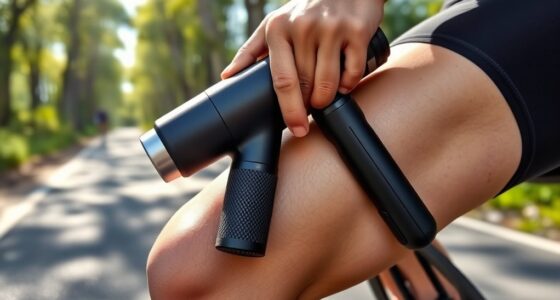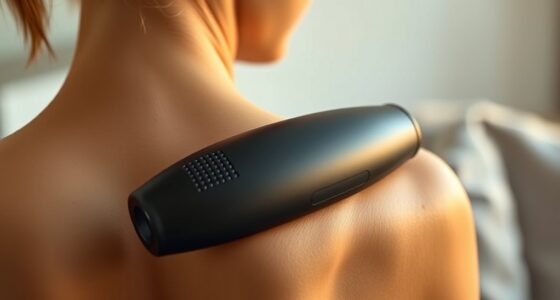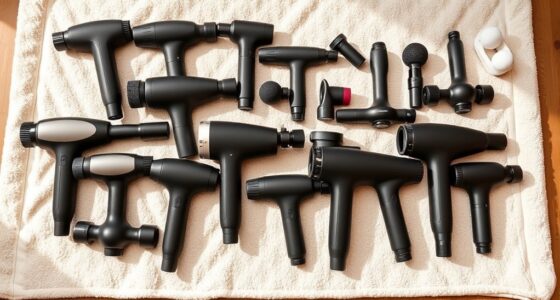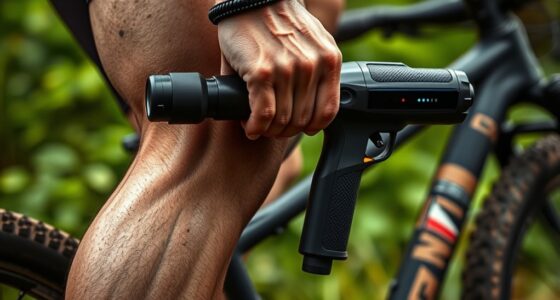If you’re looking for the best cooled CMOS astro cameras in 2025, I recommend the SVBONY SV605CC and the Astromania SGCMOS series. Both offer impressive sensor sensitivity, effective cooling for low noise, and long exposure support, making them excellent choices for deep sky imaging. They are also easy to mount and compatible with popular software. Keep exploring to discover which options suit your specific astrophotography needs perfectly.
Key Takeaways
- The SVBONY SV605CC offers a high-resolution 9MP CMOS sensor with effective TEC cooling for low-noise long exposures.
- The Astromania SGCMOS provides high sensitivity, auto-guiding support, and thermal management for detailed deep sky imaging.
- Both cameras feature versatile mounting options, easy setup, and compatibility with popular astrophotography software across multiple OS platforms.
- Advanced cooling systems in both models significantly reduce thermal noise, enabling better faint object detection during extended exposures.
- Their combination of high sensor quality, cooling efficiency, and user-friendly design makes them top choices for deep sky astrophotography in 2025.
SVBONY SV605CC Cooled Camera, 9MP CMOS Telescope Camera

If you’re serious about deep sky astrophotography, the SVBONY SV605CC cooled camera stands out with its high-resolution 9MP CMOS sensor and advanced cooling system. Its IMX533 1-inch square frame chip delivers sharp, detailed images with 3008×3008 resolution and 80% quantum efficiency, maximizing shooting efficiency. The TEC secondary refrigeration cools the sensor up to 30°C below ambient, reducing thermal noise during long exposures. With 3.76μm pixels, it captures fine details across a broad field of view. Compatible with Windows, Linux, Mac OS, Chrome OS, and Raspberry Pi, it’s versatile for indoor or outdoor use, making it ideal for deep space imaging and meteor monitoring.
Best For: amateur astronomers and astrophotographers seeking high-resolution, cooled imaging capabilities for deep sky and planetary observation.
Pros:
- High-resolution 9MP CMOS sensor with 3008×3008 pixels for detailed imaging
- Effective TEC cooling system that reduces sensor temperature up to 30°C below ambient, minimizing thermal noise
- Wide compatibility with Windows, Linux, Mac OS, Chrome OS, and Raspberry Pi for versatile use
Cons:
- Requires a compatible computer or device for operation, which may involve additional setup
- The cooling system and high-resolution sensor may increase overall cost and complexity
- Slight learning curve for beginners unfamiliar with astrophotography equipment
Astromania SGCMOS Series Telescope CMOS Camera

The Astromania SGCMOS Series Telescope CMOS Camera stands out as an excellent choice for amateur astronomers and astrophotographers seeking versatile imaging options. It features a high-sensitivity sensor supporting fast frame rates and long exposures, perfect for deep-sky imaging and auto-guiding. The aluminum CNC housing, with a 1.25-inch eyepiece interface and C-mount for industrial lenses, offers flexible setup options. Built-in ST4 auto-guider port, thermal management, and compatibility with dedicated astrophotography software make it user-friendly. Weighing about a kilogram and including essential accessories, this camera delivers reliable performance at an accessible price point, making it a popular choice among astrophotographers.
Best For: amateur astronomers and astrophotographers seeking versatile, high-sensitivity imaging solutions for deep-sky imaging and auto-guiding.
Pros:
- High-sensitivity sensor supporting fast frame rates and long exposures for detailed astrophotography.
- Versatile connection options with C-mount for industrial lenses and 1.25-inch eyepiece interface.
- Built-in ST4 auto-guiding port and thermal management for reliable performance during long observation sessions.
Cons:
- Customer ratings average only 3.5 out of 5 stars, indicating mixed reviews.
- Slightly heavier weight (~1 kg), which may require sturdy mounting setups.
- Limited information on advanced software features and compatibility, potentially requiring additional research.
Factors to Consider When Choosing Cooled CMOS Astro Cameras for Deep Sky Imaging

When selecting a cooled CMOS astro camera, I focus on sensor sensitivity and image quality to guarantee clear, detailed shots of deep sky objects. I also consider cooling efficiency to minimize noise, along with compatibility with my software and ease of setup. These factors help me choose a camera that balances performance, convenience, and image quality.
Sensor Sensitivity and Quality
Sensor sensitivity and quality are crucial factors that directly influence the performance of cooled CMOS astro cameras for deep sky imaging. Higher sensitivity, measured by quantum efficiency, allows the camera to gather more light from faint objects, resulting in brighter, more detailed images. Larger sensors with higher resolution help capture finer details, essential for revealing intricate structures in deep sky targets. Advanced noise reduction technologies, like thermal cooling, minimize thermal noise during long exposures, boosting image clarity. The overall sensor quality, including high-grade CMOS or CCD chips, directly impacts the signal-to-noise ratio and the fidelity of captured data. Additionally, the spectral response of the sensor determines its ability to record different wavelengths of light, enriching the depth and accuracy of astrophotographic data.
Cooling Efficiency and Noise Reduction
Achieving peak cooling efficiency is essential for maximizing the performance of cooled CMOS astro cameras, especially during long exposures. Effective cooling can lower sensor temperatures by 30°C or more below ambient, markedly reducing thermal noise that can obscure faint deep-sky details. Technologies like TEC (Thermoelectric Cooler) are key, as they enhance the camera’s ability to minimize residual glow and thermal signals. Higher cooling efficiency directly improves the signal-to-noise ratio, enabling clearer, more detailed images. Proper thermal management—including heat transfer design and insulation—is crucial to maintain consistent cooling and image quality throughout long sessions. When choosing a camera, look for models with robust cooling capabilities that ensure stable, efficient temperature control for optimal noise reduction during your astrophotography sessions.
Compatibility With Software
Selecting a cooled CMOS astro camera that integrates smoothly with your preferred software can make a significant difference in your imaging workflow. I look for cameras compatible with popular programs like AstroImager, SharpCap, or PHD2 to ensure seamless operation. Supporting ASCOM drivers or native software is a must, as it simplifies integration with third-party applications. Compatibility across multiple operating systems—Windows, Linux, Mac OS, or Chrome OS—gives me flexibility depending on my setup. I also check if the camera provides SDKs or APIs for custom software development or advanced control. Ensuring the software supports long exposures, dark frame calibration, and image stacking is essential for high-quality deep sky imaging. Overall, software compatibility directly impacts ease of use, efficiency, and the quality of my astrophotography results.
Resolution and Pixel Size
When choosing a cooled CMOS astro camera for deep sky imaging, understanding resolution and pixel size is essential because these factors directly impact the level of detail and sensitivity in your images. Higher resolution allows for capturing more intricate details of faint objects, improving overall image quality. Pixel size, measured in micrometers, influences both sensitivity and resolving power; smaller pixels provide higher resolution but often need longer exposures, while larger pixels enhance signal-to-noise ratios in low-light conditions. Striking a balance between pixel size and resolution is key—larger pixels can improve sensitivity, but higher resolution captures finer structures. Together, these factors determine your camera’s field of view and post-processing flexibility, enabling you to extract maximum detail from your astrophotos.
Ease of Mounting Setup
Choosing a cooled CMOS astro camera with a user-friendly mounting system can considerably simplify your setup process. Opt for one with a standard interface like C-mount or 1.25-inch, ensuring compatibility with various telescopes and accessories. Look for cameras that feature adjustable focus mechanisms and easy-to-use adapters to help you achieve precise alignment effortlessly. Cameras with straightforward mounting hardware and clear instructions cut down setup time and reduce alignment errors, saving you frustration. If you plan to switch between multiple telescopes or imaging setups, verify that the design supports quick attachment and detachment. Reliable, tool-free mounting options or quick-release systems are especially valuable, making installation faster and smoother for both beginners and seasoned astrophotographers alike.
Long Exposure Capabilities
Long exposure capabilities play a crucial role in capturing faint deep sky objects, making it possible to gather enough light for detailed images. Extended exposures allow the camera to collect more photons, revealing dim features that short exposures can’t capture. Effective thermal regulation, like TEC cooling, minimizes thermal noise during these long sessions, resulting in clearer images. The camera’s data transfer speed and buffer capacity are also vital, as they determine how long you can expose without data loss or lag. Sensor sensitivity and quantum efficiency directly influence how well the camera detects faint signals, impacting overall image quality. Finally, stable mounting and proper cooling are essential to prevent vibrations and temperature fluctuations, which can blur or distort long exposure images.
Price and Budget Constraints
Cooled CMOS astro cameras come in a wide range of prices, from just a few hundred dollars for entry-level models to several thousand for high-end options. Your budget will influence your choices, often limiting you to cameras with lower resolution, fewer advanced features, or less effective cooling systems. However, more expensive models typically offer higher quantum efficiency, better thermal management, and superior image quality, which can justify the higher cost. When planning your purchase, it’s important to account for additional expenses like accessories, software, and potential upgrades. Finding a balance between your budget and your imaging goals is key. Selecting a camera that fits your financial constraints while meeting your deep-sky imaging needs ensures you get the best value without overspending.
Frequently Asked Questions
How Does Cooling Affect Image Noise in CMOS Astro Cameras?
Cooling greatly reduces image noise in CMOS astro cameras by lowering the sensor’s temperature, which diminishes thermal noise. When I cool my camera, I notice cleaner, more detailed images with less graininess, especially during long exposures. This improvement allows me to capture faint deep-sky objects more effectively. Without cooling, noise can obscure subtle details, making cooling a vital step for high-quality astrophotography.
What Is the Typical Lifespan of Cooled CMOS Sensors?
Think of a cooled CMOS sensor like a well-tended garden; with proper care, it blooms longer. Typically, these sensors last around 5 to 10 years, depending on usage and environmental conditions. I’ve found that gentle handling and regular maintenance help extend their lifespan. While technology evolves, taking good care of your sensor guarantees it remains a reliable eye on the cosmos for many years to come.
Are Cooled CMOS Cameras Compatible With All Telescope Mounts?
Cooled CMOS cameras are generally compatible with most telescope mounts, but you should check the camera’s connector type and mounting options. I recommend verifying your mount’s compatibility with the camera’s interface and ensuring it can handle the camera’s weight and power requirements. Most modern mounts support standard connections like USB, Ethernet, or dedicated astrophotography interfaces, making integration straightforward for enthusiasts like us.
How Much Does Advanced Cooling Technology Impact Camera Cost?
Advanced cooling technology can increase a camera’s cost by roughly 30-50%. I’ve seen high-end cooled CMOS astro cameras priced considerably higher due to their sophisticated cooling systems, which reduce noise and improve image quality. This investment can be worth it if you’re serious about astrophotography, as it enhances your imaging results. So, yes, advanced cooling definitely impacts the price, but it often pays off with better images.
Can Cooled CMOS Cameras Be Used for Planetary Imaging?
Yes, cooled CMOS cameras can be used for planetary imaging, but they’re primarily optimized for deep-sky objects. I’ve found that their lower noise levels help capture fine details, but high frame rates and fast shutter speeds are essential for planets. If you’re focusing on planets, consider a camera designed specifically for high-speed imaging. Cooled CMOS cameras are versatile, but matching the camera to your specific target yields the best results.
Conclusion
If you’re serious about deep sky imaging in 2025, choosing the right cooled CMOS camera is essential. With options like the SVBONY SV605CC and Astromania SGCMOS, you can capture stunning detail. But do you really want to settle for less when your astrophotography dreams are within reach? Investing in the right gear makes all the difference—so why not take the leap and elevate your night sky captures today?








